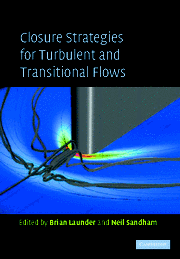12 - Large-Eddy Simulation of the Flow past Bluff Bodies
Published online by Cambridge University Press: 06 July 2010
Summary
Abstract
The flow past bluff bodies, which occurs in many engineering situations, is very complex, involving often unsteady behaviour and dominant large-scale structures; it is therefore not very amenable to simulation by the RANS method using statistical turbulence models. The large-eddy simulation technique is more suitable for these flows. In this section work in the area of large-eddy simulations of bluff body flows is summarised, with emphasis on work by the author's research group as well as on experiences gained from two LES workshops. Results are presented and compared for the vortex-shedding flow past square and circular cylinders and for the flow around surface-mounted cubes. The performance, the cost and the potential of the LES method for simulating bluff body flows, also vis-à-vis RANS methods, is assessed.
Introduction
In many engineering situations, bluff bodies are exposed to flow, generating complex phenomena such as flow separation and often even multiple separation with partial reattachment, vortex shedding, bi-modal flow behaviour, high turbulence level and large-scale turbulent structures which contribute considerably to the momentum, heat and mass transport. For solving practical problems, there is a great demand for methods for predicting such flows and associated heat and mass-transfer processes, in particular the loading, including dynamic loading on the bodies and the scalar transport in the vicinity of structures. Usually the Reynolds number is high in practical problems so that turbulent transport processes are important and must be accounted for in a prediction method in one way or another. Until recently, mainly RANS based methods were used in which the entire spectrum of the turbulent motion is simulated by a statistical turbulence model. In vortex-shedding situations, unsteady RANS equations are solved to determine the periodic shedding motion and only the superimposed stochastic turbulent fluctuations are simulated with the turbulence model. So far, mainly variants of the k-ϵ eddy-viscosity turbulence model have been used for calculating the flow around bluff bodies, but some results have been reported that were obtained with Reynolds-stress models.
The RANS calculations have shown that statistical turbulence models have difficulties with the complex phenomena mentioned above, especially when large-scale eddy structures dominate the turbulent transport and when unsteady processes like vortex shedding and bistable behaviour prevail and dynamic loading is of importance.
- Type
- Chapter
- Information
- Closure Strategies for Turbulent and Transitional Flows , pp. 361 - 391Publisher: Cambridge University PressPrint publication year: 2002
- 3
- Cited by



